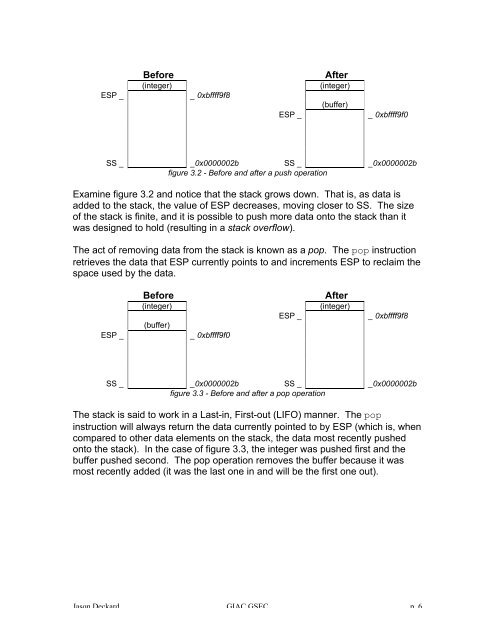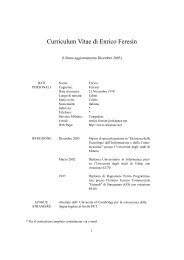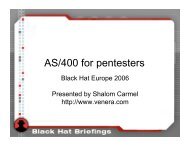Defeating Overflow Attacks - orkspace.net
Defeating Overflow Attacks - orkspace.net
Defeating Overflow Attacks - orkspace.net
Create successful ePaper yourself
Turn your PDF publications into a flip-book with our unique Google optimized e-Paper software.
ESP _<br />
Before<br />
(integer)<br />
_ 0xbffff9f8<br />
ESP _<br />
After<br />
(integer)<br />
(buffer)<br />
_ 0xbffff9f0<br />
SS _ _0x0000002b SS _ _0x0000002b<br />
figure 3.2 - Before and after a push operation<br />
Examine figure 3.2 and notice that the stack grows down. That is, as data is<br />
added to the stack, the value of ESP decreases, moving closer to SS. The size<br />
of the stack is finite, and it is possible to push more data onto the stack than it<br />
was designed to hold (resulting in a stack overflow).<br />
The act of removing data from the stack is known as a pop. The pop instruction<br />
retrieves the data that ESP currently points to and increments ESP to reclaim the<br />
space used by the data.<br />
ESP _<br />
Before<br />
(integer)<br />
(buffer)<br />
_ 0xbffff9f0<br />
ESP _<br />
After<br />
(integer)<br />
_ 0xbffff9f8<br />
SS _ _0x0000002b SS _ _0x0000002b<br />
figure 3.3 - Before and after a pop operation<br />
The stack is said to work in a Last-in, First-out (LIFO) manner. The pop<br />
instruction will always return the data currently pointed to by ESP (which is, when<br />
compared to other data elements on the stack, the data most recently pushed<br />
onto the stack). In the case of figure 3.3, the integer was pushed first and the<br />
buffer pushed second. The pop operation removes the buffer because it was<br />
most recently added (it was the last one in and will be the first one out).<br />
Jason Deckard GIAC GSEC p. 6






